Pioneer RS-P90, RS-D7R User Manual
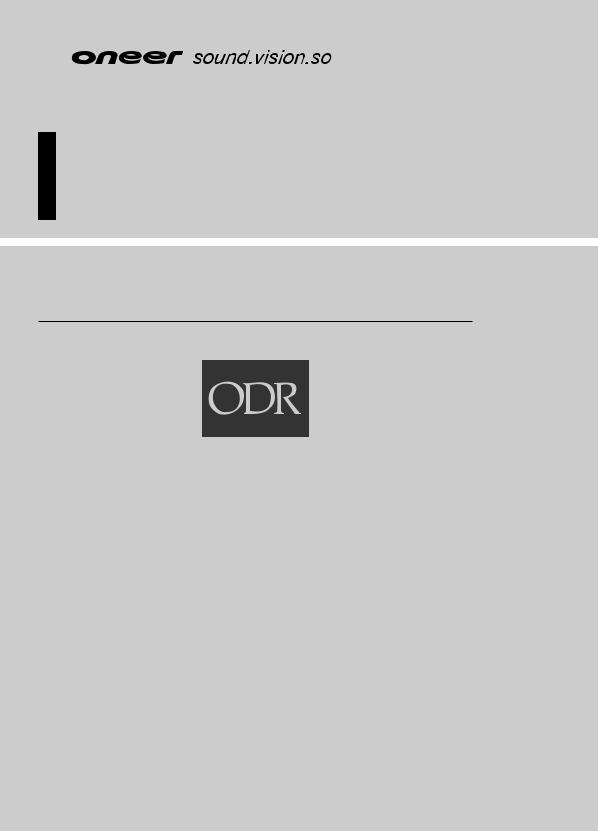
 Optical Digital Reference System
Optical Digital Reference System 
Universal Digital Preamp/equalizer
Optical Digital Reference System
Universal Digital Preamp
Owner’s Manual
RS-P90
Owner’s Manual
RS-P90
English
1
ENG/MASTER COVER 98

Contents |
|
Key Finder .................................................... |
4 |
Head unit (RS-D7R—) ...................................... |
4 |
Remote control (RS-D7R—) .............................. |
4 |
Opening and closing |
|
the remote control cover ............................ |
5 |
-When the cover is closed
-When the cover is open
Before Using This Product |
...................... 7 |
About this unit .................................................. |
7 |
About this manual ............................................ |
8 |
In case of trouble .............................................. |
8 |
Product registration ............................................ |
8 |
About the digital network .................................. |
9 |
Resetting the microprocessor .......................... |
10 |
Audio Adjustment .................................... |
11 |
Audio menu .................................................... |
11 |
- Switching to the audio menu |
|
Audio Adjustment <Main> .................... |
12 |
Main menu ...................................................... |
12 |
- Switching to the main menu |
|
Balance adjustment ........................................ |
12 |
Bass/treble adjustment .................................... |
13 |
Using the compression .................................... |
14 |
Adjusting the listening position ...................... |
15 |
-Using the position selector
-Fine tuning the position
-Effective distance adjustment
using the position fine tuning function
Source level adjustment .................................. |
19 |
Audio Adjustment <Equalizer> .............. |
20 |
About the equalizer menu .............................. |
20 |
- 31 band graphic equalizer |
|
- 3 band parametric equalizer |
|
Equalizer menu ................................................ |
21 |
- Switching to the equalizer menu |
|
Relation between frequency characteristics |
|
and sound quality .................................... |
22 |
Adjusting the 31 band graphic equalizer ........ |
24 |
Adjusting the 3 band parametric equalizer ...... |
25 |
- About the adjustment using |
|
the parametric equalizer |
|
- Setting the equalizer curve |
|
The flat function .............................................. |
28 |
The clear function ............................................ |
29 |
2
2
ENG/MASTER 96

Audio Adjustment <Network> .............. |
30 |
What is the multi-amp system? ...................... |
30 |
Network menu ................................................ |
31 |
- Switching to the network menu |
|
Time alignment adjustment ............................ |
32 |
-Switching to the
time alignment adjustment mode
-Measuring the distance to be corrected
-Inputting the distance to be corrected
Filter adjustment .............................................. |
36 |
-Switching to the filter adjustment mode
-Using the mute function
-Adjusting the filter
Switching between linear phase |
|
characteristics/minimum delay phase |
|
characteristics .......................................... |
41 |
-Linear phase characteristics
-Minimum delay phase characteristics
-Switching between linear phase characteristics/minimum delay phase characteristics
Audio Adjustment |
|
<Memory Functions> ........................ |
42 |
Memory functions of |
|
adjusted audio menu ................................ |
42 |
Switching to memory mode ............................ |
43 |
- Equalizer menu |
|
- Network menu |
|
Storing the adjustment data in memory .......... |
44 |
Recalling data stored in memory .................... |
45 |
-Recalling memory using forward/reverse order
— Functions of equalizer menu —
-Specifying the memory number directly
Memory protect function ................................ |
47 |
Display for the Person who Set Up |
|
Contents |
|
the Audio Adjustments |
48 |
||
|
|||
Inputting the name .......................................... |
48 |
|
|
Inputting characters ........................................ |
48 |
|
|
Memory Data Memo ................................ |
51 |
|
|
Connecting the Units .............................. |
54 |
|
|
WARNING ...................................................... |
54 |
|
|
CAUTION ...................................................... |
54 |
|
|
Routing the optical cable ................................ |
55 |
|
|
Setting example .............................................. |
55 |
|
|
Connection diagram ........................................ |
56 |
|
|
Connecting the RCA input amplifier .............. |
57 |
|
|
Connecting the power terminal ...................... |
58 |
|
|
Secure the optical cable .................................. |
59 |
|
|
Installation ................................................ |
60 |
|
|
Installing the unit ............................................ |
60 |
|
|
Troubleshooting ...................................... |
61 |
|
|
Checklist .......................................................... |
61 |
|
|
Specifications .......................................... |
62 |
|
3
3
ENG/MASTER 96
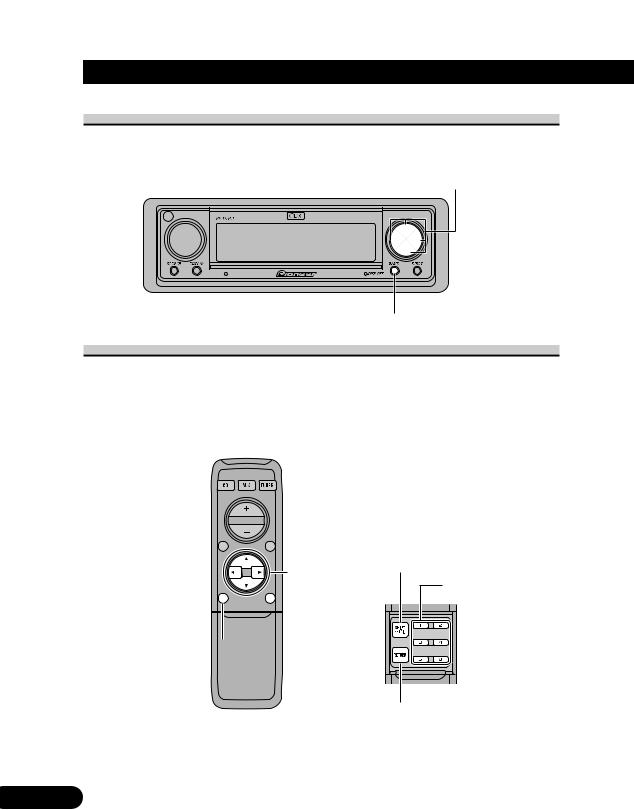
Key Finder
Head unit (RS-D7R—)
This unit can be operated with the combined head unit RS-D7R— (sold separately).
5/∞/2/3 buttons
These buttons can not be used in the Audio Adjustment operation.
BAND button 
Remote control (RS-D7R—)
Most of all functions can be operated by the remote control.
Opening the cover enables the SHIFT, RETURN and FUNCTION buttons 1 to 6 inside the remote control. For more details, refer to the page 5.
SHIFT button
5/∞/2/3 buttons
FUNCTION buttons 1 to 6
 BAND button
BAND button
MENU button 
RETURN button
Closed state |
Open state |
4
CRB1635 4 ENG/MASTER 96
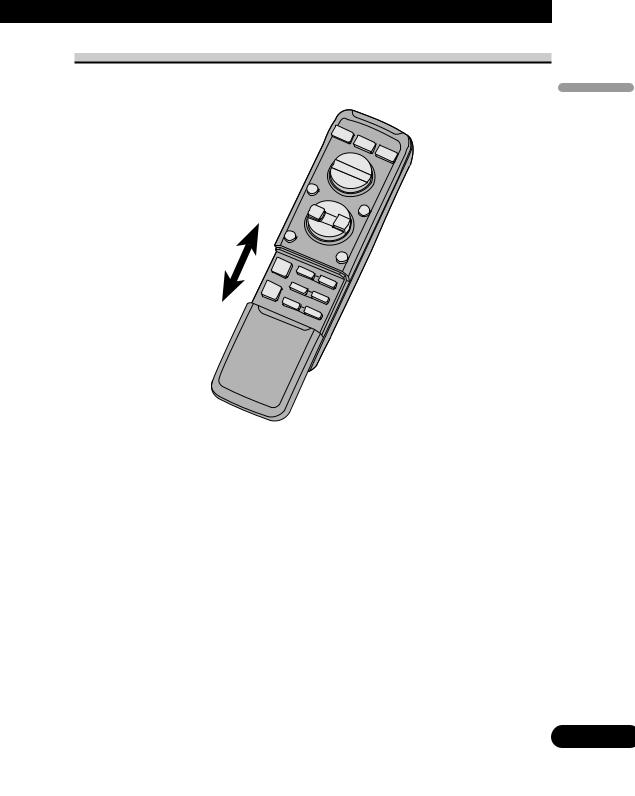
Opening and closing the remote control cover
When the remote control is opening the cover enables the SHIFT, RETURN and FUNCTION buttons 1 to 6 inside the unit.
Finder Key
Menu displays with cover open and closed in this system, the available functions and the menu display vary depending on the condition of the remote control in use.
Remote control |
Menu display |
Cover closed |
Closed state |
|
|
Cover open |
Open State |
|
|
5
ENG/MASTER 96
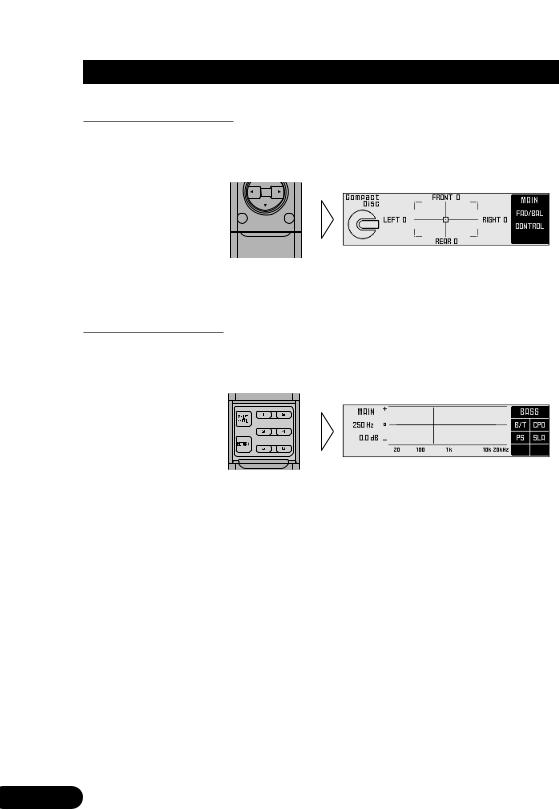
Key Finder
When the cover is closed
Closing the cover of the remote control makes the menu display to the closed state.
Menu display in closed state
Example: Main menu screen
Note:
• Menu display in closed state: Current mode and functions which are ON are displayed.
When the cover is open
Opening the cover of the remote control makes the menu display to the open state.
Menu display in open state
Example: Main menu setting screen
Note:
•Positions of menu items on the display correspond to the positions of FUNCTION buttons 1 to 6.
•Menu display in open state: Using FUNCTION buttons 1 to 6, operable functions are displayed.
When the cover is closed in the middle of operation
•Closing the cover during operation releases the previous operation and returns the menu display to the closed mode.
6
6
ENG/MASTER 96
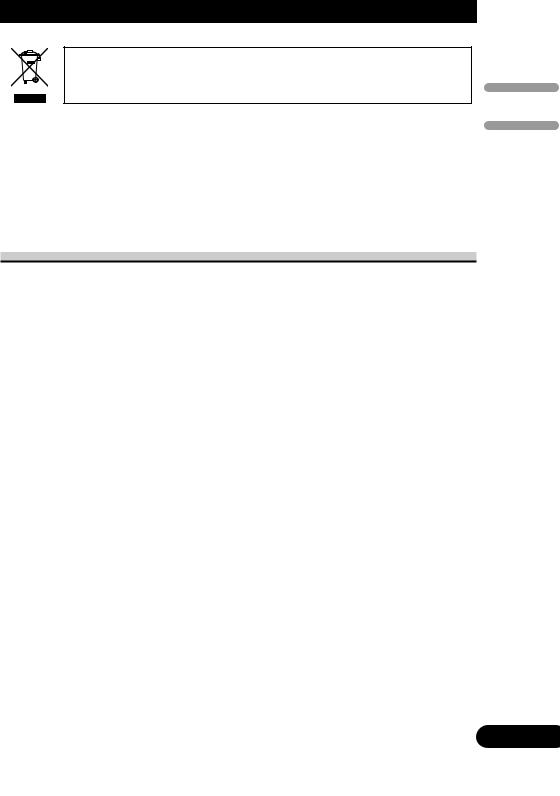
Before Using This Product
If you want to dispose this product, do not mix it with general household waste. There is a separate collection system for used electronic products in accordance with legislation that requires proper treatment, recovery and recycling.
Private households in the 25 member states of the EU, in Switzerland and Norway may return their used electronic products free of charge to designated collection
retailer (if you purchase a similar new one).
For countries not mentioned above, please contact your local authorities for the correct method of disposal.
By doing so you will ensure that your disposed product undergoes the necessary treatment, recovery and recycling and thus prevent potential negative effects on the environment and human health.
About this unit
This unit is universal digital preamp which can be operated with the combined head unit RS-D7R— (sold separately). You can operate a number of audio adjustment functions with separately sold head unit.
 CAUTION:
CAUTION:
•Do not allow this unit to come into contact with liquids. Electrical shock could result. Also, this unit damage, smoke, and overheat could result from contact with liquids.
•Keep this manual handy as a reference for operating procedures and precautions.
•Always keep the volume low enough so that you can hear sounds from outside the vehicle.
•Protect this unit from moisture.
•If the battery is disconnected or discharged, the preset memory will be erased and must be reprogrammed.
7
ENG/MASTER 96

Before Using This Product
About this manual
This unit features a number of sophisticated functions ensuring superior reception and operation. All the functions have been designed for the easiest possible use, but many are not self-explanatory. This operation manual will help you benefit fully from this unit’s potential and to maximize your listening enjoyment.
We recommend that you farmiliarize yourself with the functions and their operation by reading the manual before you begin using this unit. It is especially important that you read and observe WARNINGs and CAUTIONs in this manual.
This manual mainly explains the remote control operation. Some functions can be operated with the head unit, however, the remote control offers a number of buttons such as SHIFT, MENU, RETURN and FUNCTION buttons 1 to 6 which are not provided on the head unit. And all of audio adjustment operations can only be conducted with the remote control.
In case of trouble
Should this product fail to operate properly, contact your dealer or nearest authorized Pioneer Service Station.
Product registration
Visit us at the following site:
•Register your product. We will keep the details of your purchase on file to help you refer to this information in the event of an insurance claim such as loss or theft.
8
8
ENG/MASTER 96

About the digital network
A vehicle, unlike the home audio, imposes several constraints upon the quality of reproduced sound, and have the following effects:
•Reflected sounds have strong effects on direct sounds because of the confined space and complex shape within a vehicle. This disturbs frequency characteristics and significantly reduces sound quality.
•The orientation of the sound image becomes unnatural, because speakers may not be installed symmetrically to left and right of the listener, or because speakers are installed in both the front and rear.
This system is equipped with a wide variety of functions that use DSP to create the ideal sound quality and sound image in a vehicle and overcome these constraints on reverberation.
Product This Using Before
9
ENG/MASTER 96
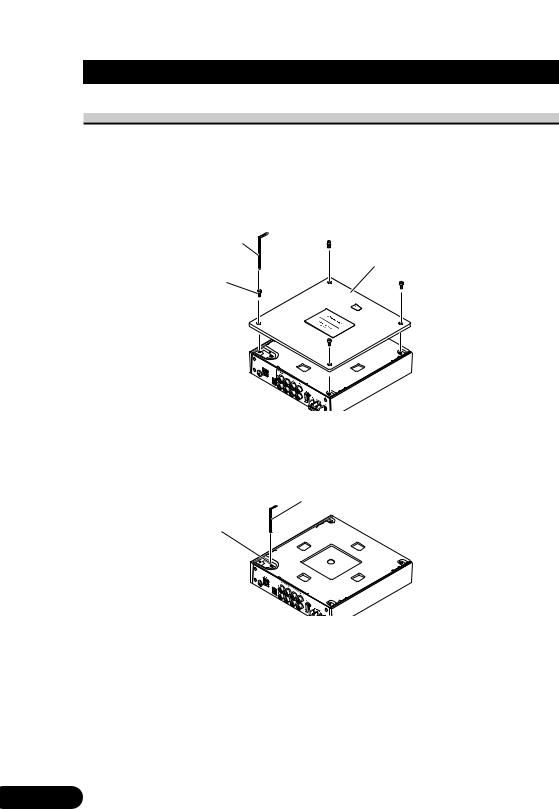
Before Using This Product
Resetting the microprocessor
The microprocessor must be reset under the following conditions:
•When using this unit for the first time after installation.
•When the machine fails to operate properly.
•When strange (incorrect) messages appear on the display.
1.Remove the covering.
Hexagonal wrench
Covering
Screw
2. Press the RESET button on this unit with a supplied hexagonal wrench.
Hexagonal wrench
RESET button
3.Replace the cover to assure the reset button is not accidentally pressed.
The cover may be attached vertically or horizontally.
10
10
ENG/MASTER 96
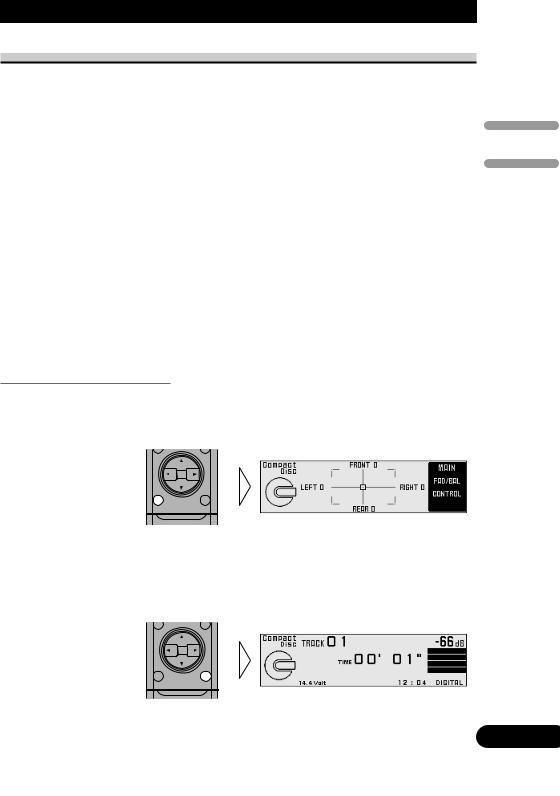
Audio Adjustment
Audio menu
This system has the following three audio menus:
Main <Main> (page 12)
This carries out balance adjustments as well as bass/treble adjustment, the basis for sound quality adjustments. It also sets up and adjusts the position selector, which corrects the orientation of the sound image for the listener’s position in the vehicle.
Equalizer <Equalizer> (page 20)
This corrects complex frequency disturbance in a vehicle.
The equalizer function for the component can make fine adjustments of sound quality for each frequency.
Network <Network> (page 30)
This adjusts the reproduced frequency band (cross-over frequency) and the level of each sound range (band) when a multi-amp system is set up. It also corrects unnatural orientation of the sound image caused by the locations of the speakers (using the time alignment function), by setting up a delay (time difference) between speakers set up for different sound ranges.
Note:
•The 5/∞/2/3 buttons on the head unit (RS-D7R—) can not be used for audio adjustment operations.
Switching to the audio menu
When the system is ON, you can adjust the sound quality.
1.Each press of MENU button selects the desired audio menu in the following order:
Main (main menu) = Equalizer (equalizer menu) = Network (network menu)
2.Operate the mode.
3.Press the BAND button and cancel the audio menu.
Cancel the audio menu to return to the operations screen of the source currently in use.
11
ENG/MASTER 96
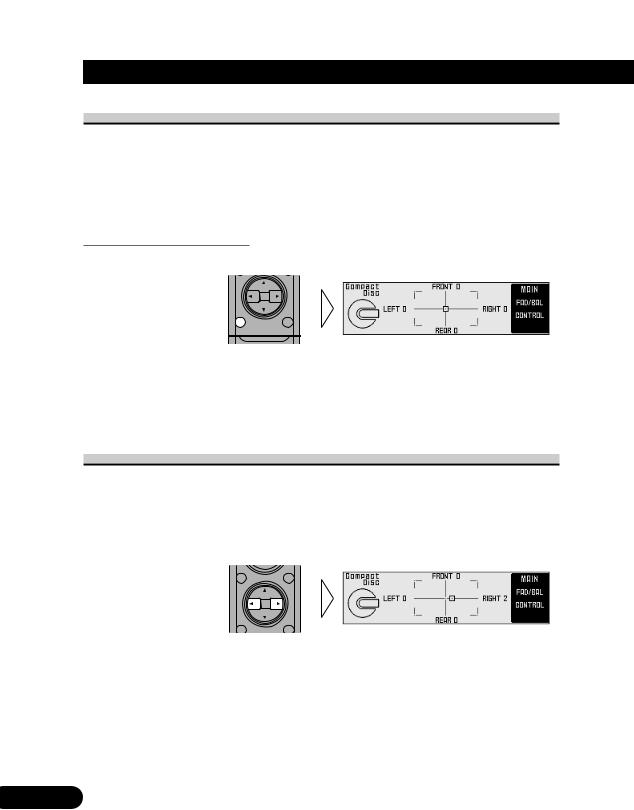
Audio Adjustment <Main>
Main menu
With this menu, you can make the following adjustments.
•Balance adjustment <FAD/BAL CONTROL> (Closed state)
•Bass/treble adjustment <B/T> (Open state)
•Using the compression <CP> (Open state)
•Listening position adjustment <PS> (Open state)
•Source level adjustment <SLA> (Open state)
Switching to the main menu
• Press the MENU button and select the main menu.
After the title screen, the display switches to the operation screen of the main menu. Opening and closing the cover of the remote control (refer to page 5) switches between the open and closed states of the menu display and setting screen.
• To cancel the main menu, press the BAND button.
Balance adjustment <FAD/BAL CONTROL> (Closed state)
This function allows you to select a balance setting that provides ideal listening conditions in all occupied seats. This function can be operated with the remote control cover closed.
1.Close the cover of the remote control (refer to page 5).
2.Adjust left/right speaker balance with the 2/3 buttons.
12
12
ENG/MASTER 96
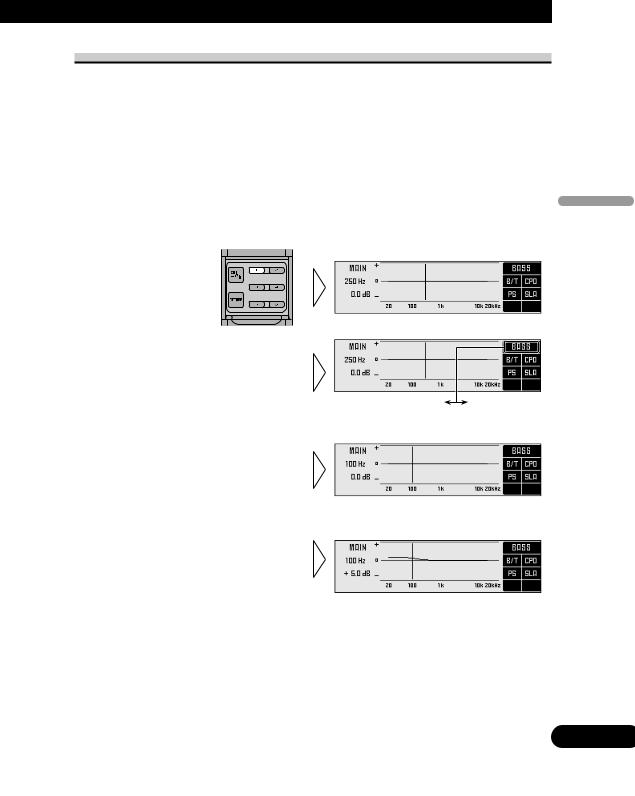
Bass/treble adjustment <B/T> (Open state)
It is possible to select one from a choice of four frequencies to becomes the reference when adjusting the bass/treble tone. The frequencies and level adjustment ranges from which selections may be made are as follows:
Bass : 63 Hz, 100 Hz, 160 Hz, 250 Hz
Treble: 4 kHz, 6.3 kHz, 10 kHz, 16 kHz
Level adjustment range: –12 dB to +12 dB (1 dB/1 step)
1.Open the cover of the remote control (refer to page 5).
This switches to main menu setting screen.
2.Press the FUNCTION button 1.
The display switches to bass/treble adjustment screen.
3.Press the FUNCTION button 1 again to choose bass (BASS) or treble (TREB).
Pressing the button switches |
BASS |
TREB |
bass/treble. |
4.Press the 2/3 buttons and select a frequency point.
Tune to the desired frequency point.
5.Press the 5/∞ buttons and adjust the level.
Holding down these buttons continues their operations (with one stop at the central position).
Note:
•Raising the bass/treble level too high may result in distortion. Perform bass/treble adjustment to adjust overall sound quality.
<Main> Adjustment Audio
13
ENG/MASTER 96
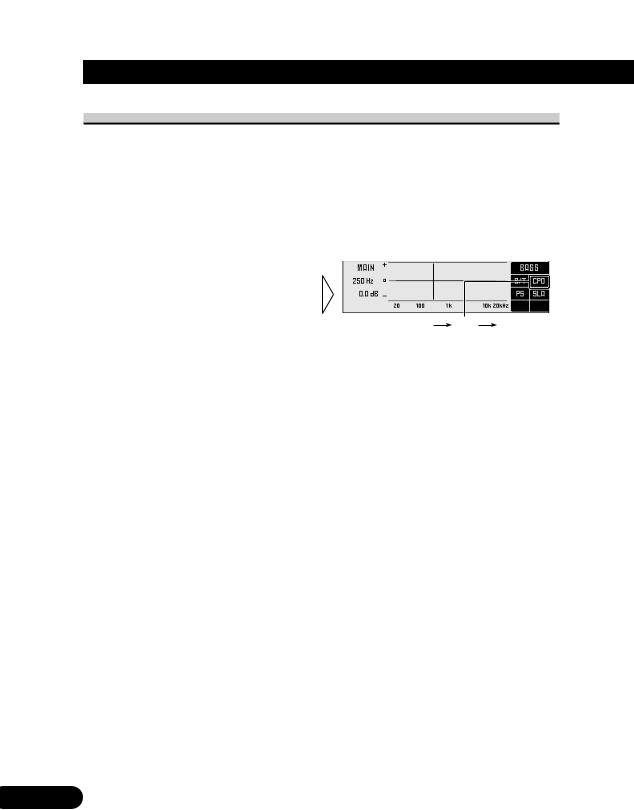
Audio Adjustment <Main>
Using the compression <CP> (Open state)
You can reduce the difference between the volume levels of loud and quiet sounds. The compression function suppresses loud sounds and boosts quiet sounds to reduce the
difference between the volume levels of loud and quiet sounds. It is convenient to use this function when you want to hear quiet sounds more clearly.
•CP2 (compression 2) has a larger effect than CP1 (compression 1).
1.Open the cover of the remote control (refer to page 5).
This switches to main menu setting screen.
2.Press the FUNCTION button 2
to select the setting.
Pressing the button switches the mode |
|
|
|
in the following order : |
|
|
|
CP0 = CP1 = CP2 |
CP0 |
CP1 |
CP2 |
14
14
ENG/MASTER 96
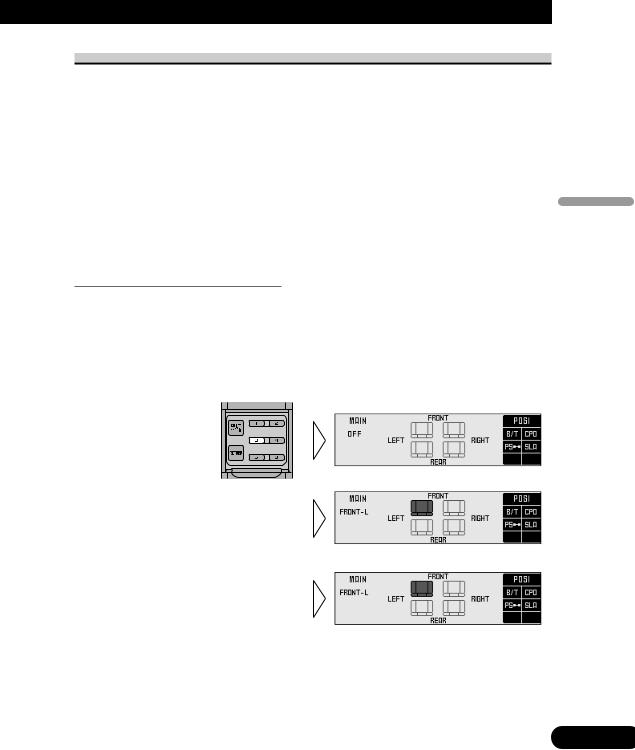
Adjusting the listening position <PS> (Open state)
One way to assure a more natural sound is to clearly position the stereo sound image (putting you in the center of the sound field).
The position selector function adjusts distance and volume level of sound from each speaker to match seat positions and the number of people in the car, and lets you recall settings at the touch of a button. The result is a natural sound regardless of the seat you are sitting in.
Button |
Position |
5 |
FRONT (Front seat left & right) |
|
|
2 |
FRONT-L (Front seat left) |
|
|
3 |
FRONT-R (Front seat right) |
|
|
Using the position selector <POSI>
1.Open the cover of the remote control in the main menu (refer to page 5).
This switches to main menu setting screen.
2.Press the FUNCTION button 3.
The display switches to position selector screen.
3.Press the FUNCTION button 3 again to turn the position selector function ON.
4.Press one of buttons 2/3/5 and select the desired position.
Set up the position to match the position of the listener in the car.
Experimenting with other positions
•The position is normally designed to match the listener’s position in the car. However, other positions may prove to be more effective, depending on the model of the car and the location of the speakers. Compare the sound and choose the position in which the sounds are most natural.
15
<Main> Adjustment Audio
15
ENG/MASTER 96
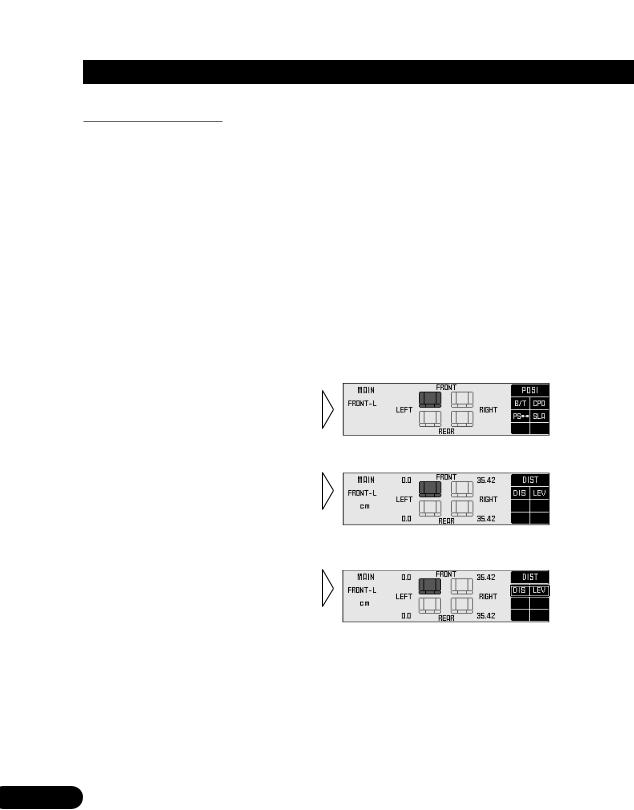
Audio Adjustment <Main>
Fine tuning the position
You can finely adjust the differences in distance and sound levels for the position selected with the position selector function. Make adjustments using both methods to match the location of the speakers and the shape of your vehicle until you achieve more natural sound imaging.
Difference in distance adjustment range: 0.0 cm to 192.5 cm (0.77 cm/1 step)
The larger the difference in distance, the sooner sound from the speaker reaches your ears, so the speaker seems to move closer. Consequently, the sound image moves in the direction in which the value for the difference in distance is larger.
Adjustment range in the difference in sound levels (LEV): 0 dB to –30 dB (0.5 dB/1 step)
The smaller the level, the lower the sound volume output from the speaker, giving the listener the feeling that the speaker is moving further away. The sound image thus moves in the direction in which the value for the difference in sound levels is closer to 0.
Note:
•Fine tuning can be conducted separately for each position.
•The values set after fine tuning are stored into memory as the values for the position. When the position is next called up, the fine tuning values are recalled.
1.Use the position selector function and select the position.
Example: When selecting FRONT–L
2.Press the FUNCTION button 3 for two seconds and switch to position fine tuning screen.
3.Press FUNCTION button 1 or 2, and select to adjust difference in
distance or difference in sound levels.
16
16
ENG/MASTER 96
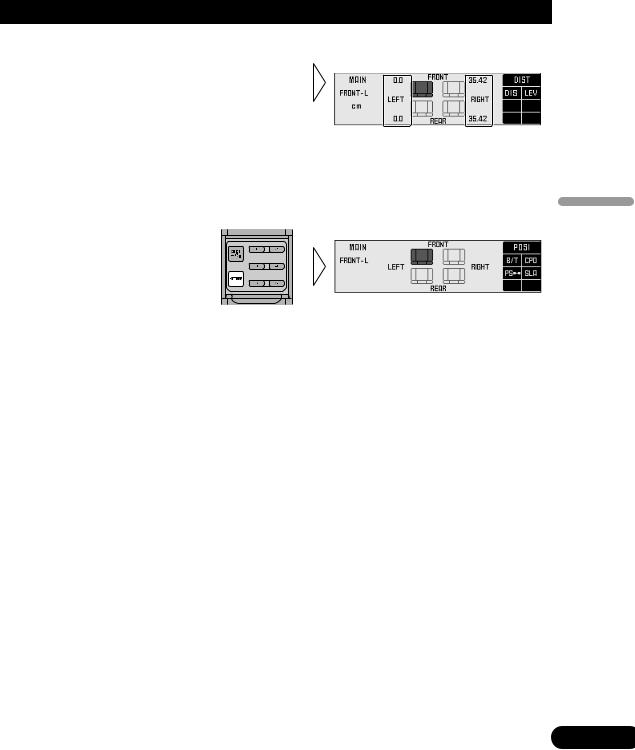
4.Press the 2/3 buttons to correct the position of the sound image.
Holding down these buttons continues their operations (during the difference in distance tuning, holding down the button moves the distance 1.54 cm/1 step).
5.After tuning has been completed, press the RETURN button to cancel the position fine tuning screen.
The values are stored in memory and the display returns to position selector screen.
Points concerning fine tuning
•While listening to vocals, adjust the distance to position the vocal sound image naturally to the front.
17
<Main> Adjustment Audio
17
ENG/MASTER 96

Audio Adjustment <Main>
Effective distance adjustment using the position fine tuning function
— Relation to time alignment adjustment function —
The distance between the listening position and each speaker can be tuned using either of two methods.
Time alignment adjustment function of the network menu (page 32)
The distance between the listening position and each speaker of each band (high, mid, low and subwoofer) can be adjusted for the left and right speakers.
Adjustment of difference in distance with the position fine tuning function
Overall adjustment is performed for left and right speakers regardless of the band. The same adjustments are made for high, midrange, low and subwoofer bands.
Combine the two methods to ensure the position of the sound images are set up more effectively.
1.Adjust the distance from each speaker using the time alignment adjustment function of the network menu (refer to page 32).
2.Adjust the overall distance balance between the left and right speakers using the position fine tuning function.
Use the set values for the time alignment adjustment function to fine tune the overall balance of the sound image positions.
3.Use the position fine tuning function to adjust the overall level balance between the left and right speakers.
Adjust the difference in sound levels between the left and right speakers so that the sound image is in the front.
When you have made adjustments for difference in distance using the position fine tuning function
•After adjusting the difference in distance with the position fine tuning function and switching to the time alignment adjustment screen, the values set using the position fine tuning function are added to the values previously set using the time alignment function and the sum values are displayed.
•If you want to store the displayed values in memory as new values for the time alignment function (standard values for the position fine tuning function), adjust any on value again by pressing the 5/∞ buttons. The displayed values are stored in memory and the difference in distance set with the position fine tuning function is reset and returned to 0.
When the distance has been using the time alignment adjustment function
•Adjustment of the difference in distance using the position fine tuning function is based on time alignment adjustment delay time. When you have set a delay time using the time alignment adjustment function, since the standard value is changed, the difference in distance set using the position fine tuning function is reset and returned to 0.
18
18
ENG/MASTER 96
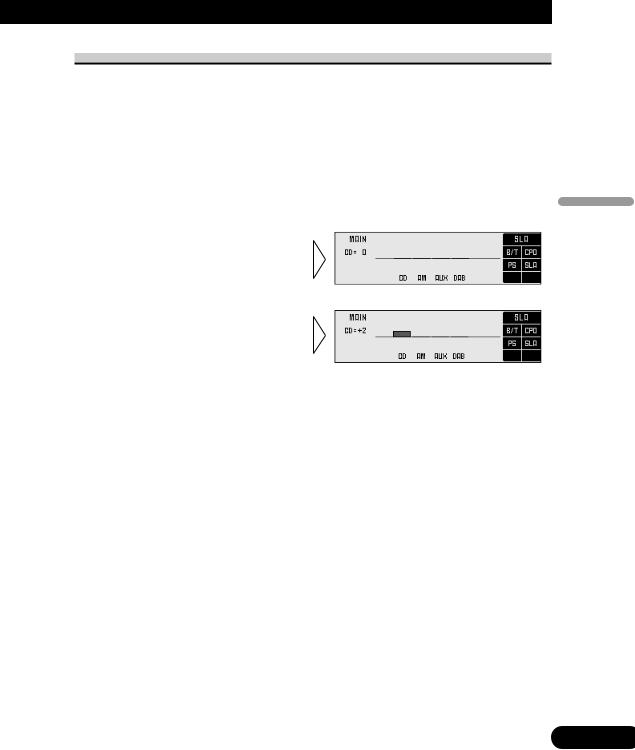
Source level adjustment <SLA> (Open state)
The SLA (source level adjustment) function prevents radical leaps in volume level when switching between sources. Settings are based on the FM volume level, which remains unchanged.
1.Compare the FM volume with the volume of the other source (refer to RS-D7R— (sold separately) owner’s manual).
2.Press the MENU button to switch to the main menu.
3.Open the cover of the remote control switches to main menu setting screen.
4.Press FUNCTION button 4 on main menu setting screen.
The display switches to SLA adjustment screen.
5.Increase or decrease the level with the 5/∞ buttons.
The display shows “+4” to “–4”.
Note:
•Since the FM volume is the control, SLA is not possible in the FM modes.
•The MW/LW volume level, which is different from the FM base setting volume level, can also be adjusted similar to sources other than tuner.
•The head unit’s CD player, Multi-CD player and DVD player are set to the same volume adjustment setting automatically.
•AUX, External 1 and External 2 are set to the same volume adjustment setting automatically.
19
<Main> Adjustment Audio
19
ENG/MASTER 96

Audio Adjustment <Equalizer>
About the equalizer menu
One important factor for creating quality sound is the correction of disturbances in frequency characteristics within the complex shape of a vehicle interior.
Reflected sounds have a strong effect on direct sound in a vehicle because of the vehicle’s shape, the confined space, absorption of sound by the seats and reflection from the windows. All these cause disturbances in the frequency characteristics. Such disturbances will be apparent as reduced sound quality.
Any one of two kinds of digital equalizer is used under this system, depending upon the configuration of the audio system. The digital equalizer adjustment corrects disturbances in frequency characteristics and creates a smooth sound quality.
•As installation conditions differ for the left and right speakers, different corrections must be made for each. All two digital equalizers are able to correct the left and right speakers separately.
31 band graphic equalizer (31B-GEQ)
You can perform 31-band (1/3 octave intervals) level adjustments for left and right channels independently or combined to achieve the optimum acoustic characteristics for the environment in your vehicle.
3 band parametric equalizer (3B-PEQ)
You can perform 3-band level adjustments for left and right channels independently or combined, adjusting the levels of a choice of 31 frequencies (1/3 octave intervals) as desired. You can also adjust the inclination of the equalizer curve (Q factor) of each of the bands.
20
20
ENG/MASTER 96
